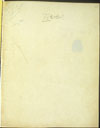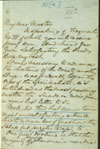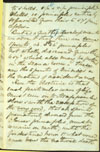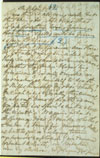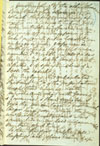Mahatma Letter No. 70a
| Quick Facts | |
|---|---|
| People involved | |
| Written by: | A. O. Hume |
| Received by: | Koot Hoomi |
| Sent via: | unknown |
| Dates | |
| Written on: | unknown |
| Received on: | August, 1882 – see below |
| Other dates: | unknown |
| Places | |
| Sent from: | unknown |
| Received at: | Simla, India |
| Via: | unknown |
This is Letter No. 70a in The Mahatma Letters to A. P. Sinnett, 4th chronological edition. It corresponds to Letter No. 20a in Barker numbering. See below for Context and background.
< Prev letter chrono
Next letter chrono >
< Prev letter Barker
Next letter Barker >
Cover sheet
|
Notes on mine to O[ld] L[ady] re. Nature rejecting the lukewarm Aug[ust] 1882 |
NOTES:
|
Page 1 transcription, image, and notes
|
My dear Master, In speaking of Fragments No. III of which you will receive proofs soon, I said it was far from satisfactory though I had done my best. It was necessary to advance the doctrine of the Society another stage, so as gradually to open the eyes of the spiritualists — so I introduced as the most pressing matter the Suicide etc. view given in your last letter to S. Well it is this that seems to me most unsatisfactory and it will lead to a number of questions that I shall feel puzzled to reply to. Our first doctrine is that the majority of objective phenomena were due |
NOTES:
|
Page 2
|
to shells. 1½ and 2½ principled shells, i.e. principles entirely separated from their sixth and seventh principles. But as a further development we admit that there are some spirits, i.e. 5th and 4th principles not wholly dissevered from their sixth and seventh which also may be potent in the seance room. These are the spirits of suicides and the victims of accident or violence. Here the doctrine is that each particular wave of life must run on to its appointed shore and with the exception of the very good, that all spirits prematurely divorced from the lower principles, must remain on earth, until the foredestined hour of what would have been the natural death |
NOTES: |
Page 3
|
strikes. Now this is all very well but this being so, it is clear that in opposition to our former doctrine, shells will be few and spirits many (1). For what difference can there be to take the case of suicides, whether these be conscious or unconscious, whether the man blows his brains out, or only drinks or womanizes himself to death, or kills himself by over-study? In each case equally the normal natural hour of death is anticipated and a spirit and not a shell the result — or again what difference does it make whether a man is hung for murder, killed in battle, in a railway train or a powder explosion, or drowned or burnt to death, or knocked over by cholera or plague, or jungle |
NOTES: |
Page 4
|
fever or any of the other thousand and one epidemic diseases of which the seeds were not ab initio, in his constitution, but were introduced therein in consequence of his happening to visit a particular locality or undergo a given experience, both of which he might have avoided? Equally in all cases the normal death hour is anticipated and a spirit instead of a shell the result. In England it is calculated that not 15% of the population reach their normal death period. And what with fevers and famines and their sequelae, I fear the percentage is not much larger here even — where the people are mostly vegetarian and as a rule live under less unfavourable sanitary conditions. So then the great bulk of all the physical phenomena of spi |
NOTES:
|
Page 5
|
ritualists ought apparently to be due to these spirits and not to shells. I should be glad to have further information on this point.(2) There is a second point. Very often as I understand the spirits of very fair average good people dying natural deaths, remain some time in the earth's atmosphere — from a few days to a few years — why cannot such as these communicate? And if they can this is a most important point that should not have been overlooked.(3) And thirdly it is a fact that thousands of spirits do appear in pure circles and teach the highest morality and moreover tell very closely the truths as to the unseen world (witness Alan Kardec's books pages on pages of which are identical with what you yourself |
NOTES:
|
Page 6
|
teach) and it is unreasonable to suppose that such are either shells or bad spirits. But you have not given us any opening for any large number of pure high spirits — and until the whole theory is properly set forth and due place made for these which seem to me a thoroughly well established fact, you will never win over the spiritualists. I dare say it is the old story — only part of the truth being told to us and the rest reserved — if so it is merely cutting the Society's throat. Better to tell the outside world nothing — than to tell them half truths the incompleteness of which they detect at once, the result being a contemptuous rejection of what is truth and though they cannot accept it in this fragmentary state.(4) Yours affectionately, |
NOTES: |
Context and background
These three letters (No. 70a, b, and c) would be very confusing without some knowledge of their background. In October 1881, The Theosophist published an article by Eliphas Levi entitled "Death". The article became the subject of some discussion and differences of opinion, and it is referred to several times in the Letters.
There were also many marginal comments by the Mahatma K.H. These are shown in the Appendix to The Letters of H. P. Blavatsky to A. P. Sinnett.
A member of the Theosophical Society by the name of N. D. Khandalawala, wrote to the editor, pointing out that, in the same issue of The Theosophist, one of the articles in the series, "Fragments of Occult Truth" seemed to him in direct contradiction to the statements made in the editor’s note accompanying Eliphas Levi’s article. “Evidently,” said Mr. Khandalawala, “there is a gap somewhere.” He asked for clarification. When H. P. Blavatsky received Mr. Khandalawala’s letter, she sent it to the Mahatma K.H. He sent it back to her with a precipitated note as follows:
Send this to Mr. Sinnett. Having now received all the necessary explanations from me, he will not refuse me the personal favor I now ask of him. Let him enlighten his brother theosophists in his turn by writing an answer to this for the next Theos. and sign himself “A Lay Chela.”
H.P.B. forwarded Mr. Khandalawala’s letter, along with K.H.’s precipitated note, to Sinnett. He went to see A. O. Hume (who was in Simla at the time) to discuss the matter. This raised some questions in Hume’s mind about an article in the series of “Fragments” that he was then working on, and he wrote to the Mahatma K.H. Hume’s letter is No. 70-A (ML-20A).
Then, Sinnett wrote to H.P.B. to try to clarify some of the points in Mr. Khandalawala’s letter. This is letter No. 70-B (ML-20B). H.P.B. referred this letter to the Mahatma KH, and the Mahatma replied to the letters from both Sinnett and Hume by writing on the back of Sinnett’s letter his answers to their questions.
Studying the contents of these three letters becomes quite complicated because some of the questions asked in both 70-A and 70-B are answered in 70-C. However, the Mahatma has inserted identifying numbers or letters, and so, by going back and forth between the three letters, some order emerges.
Physical description of letter
The original is in the British Library, Folio 1. George Linton and Virginia Hanson described this letter with related letters 70b and 70c:
20A is from AOH to KH, written on note paper in black ink. Certain passages have been underscored and reference numbers have been added in blue pencil.
20B is from APS to HPB and is written on small sheets of note paper. Certain passages have been underscored in blue pencil.
20C is from KH to APS. It is written on the back of 20A, 20B and on additional sheets of the same size. He writing is in blue pencil and has a granular appearance such as one might produce by writing with a colored pencil on paper placed on the cover of a clothbound book, or similar rough surface. A number of letters dated during the latter half of 1882 have this appearance. how this effect was produced is not known.[1]
Publication history
Commentary about this letter
Notes
- ↑ George E. Linton and Virginia Hanson, eds., Readers Guide to The Mahatma Letters to A. P. Sinnett (Adyar, Chennai, India: Theosophical Publishing House, 1972), 123.
